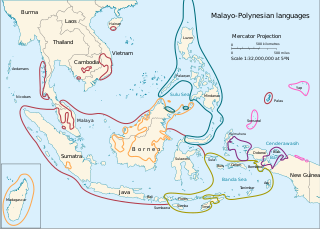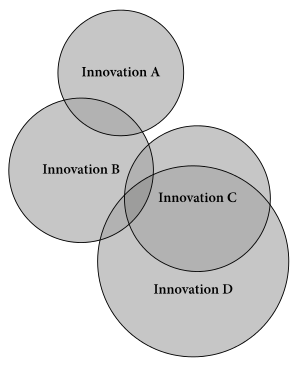
A language family is a group of languages related through descent from a common ancestral language or parental language, called the proto-language of that family. The term "family" reflects the tree model of language origination in historical linguistics, which makes use of a metaphor comparing languages to people in a biological family tree, or in a subsequent modification, to species in a phylogenetic tree of evolutionary taxonomy. Linguists therefore describe the daughter languages within a language family as being genetically related. The divergence of a proto-language into daughter languages typically occurs through geographical separation, with different regional dialects of the proto-language spoken by different speech communities undergoing different language changes and thus becoming distinct languages from each other.

The Austronesian languages are a language family widely spoken throughout Maritime Southeast Asia, parts of Mainland Southeast Asia, Madagascar, the islands of the Pacific Ocean and Taiwan. They are spoken by about 386 million people. This makes it the fifth-largest language family by number of speakers. Major Austronesian languages include Malay, Javanese, Sundanese, Tagalog, Malagasy and Cebuano. According to some estimates, the family contains 1,257 languages, which is the second most of any language family.

The Malayo-Polynesian languages are a subgroup of the Austronesian languages, with approximately 385.5 million speakers. The Malayo-Polynesian languages are spoken by the Austronesian peoples outside of Taiwan, in the island nations of Southeast Asia and the Pacific Ocean, with a smaller number in continental Asia in the areas near the Malay Peninsula, with Cambodia, Vietnam and the Chinese island Hainan as the northwest geographic outlier. Malagasy, spoken in the island of Madagascar off the eastern coast of Africa in the Indian Ocean, is the furthest western outlier.
A dialect continuum or dialect chain is a series of language varieties spoken across some geographical area such that neighboring varieties are mutually intelligible, but the differences accumulate over distance so that widely separated varieties may not be. This is a typical occurrence with widely spread languages and language families around the world, when these languages did not spread recently. Some prominent examples include the Indo-Aryan languages across large parts of India, varieties of Arabic across north Africa and southwest Asia, the Turkic languages, the Chinese languages or dialects, and parts of the Romance, Germanic and Slavic families in Europe. Terms used in older literature include dialect area and L-complex.
In the field of dialectology, a diasystem or polylectal grammar is a linguistic analysis set up to encode or represent a range of related varieties in a way that displays their structural differences.

The Philippine languages or Philippinic are a proposed group by R. David Paul Zorc (1986) and Robert Blust that include all the languages of the Philippines and northern Sulawesi, Indonesia—except Sama–Bajaw and the Molbog language—and form a subfamily of Austronesian languages. Although the Philippines is near the center of Austronesian expansion from Formosa, there is little linguistic diversity among the approximately 150 Philippine languages, suggesting that earlier diversity has been erased by the spread of the ancestor of the modern Philippine languages.
In geolinguistics, areal features are elements shared by languages or dialects in a geographic area, particularly when such features are not descended from a proto-language, i.e. a common ancestor language. That is, an areal feature is contrasted with lingual-genealogically determined similarity within the same language family. Features may diffuse from one dominant language to neighbouring languages.

The approximately 450 Oceanic languages are a branch of the Austronesian languages. The area occupied by speakers of these languages includes Polynesia, as well as much of Melanesia and Micronesia. Though covering a vast area, Oceanic languages are spoken by only two million people. The largest individual Oceanic languages are Eastern Fijian with over 600,000 speakers, and Samoan with an estimated 400,000 speakers. The Gilbertese (Kiribati), Tongan, Tahitian, Māori and Tolai languages each have over 100,000 speakers. The common ancestor which is reconstructed for this group of languages is called Proto-Oceanic.
The Manus languages are a subgroup of about two dozen Oceanic languages located on Manus Island and nearby offshore islands in Manus Province of Papua New Guinea. The exact number of languages is difficult to determine because they form a dialect continuum. The name Manus originally designated an ethnic group whose members spoke closely related languages and whose coastal dwellers tended to build their houses on stilts out over the sea.
Dialectology is the scientific study of linguistic dialect, which today is considered a sub-field of sociolinguistics. It studies variations in language based primarily on geographic distribution and their associated features. Dialectology deals with such topics as divergence of two local dialects from a common ancestor and synchronic variation.

The Eastern Algonquian languages constitute a subgroup of the Algonquian languages. Prior to European contact, Eastern Algonquian consisted of at least 17 languages, whose speakers collectively occupied the Atlantic coast of North America and adjacent inland areas, from what are now the Maritimes of Canada to North Carolina. The available information about individual languages varies widely. Some are known only from one or two documents containing words and phrases collected by missionaries, explorers or settlers, and some documents contain fragmentary evidence about more than one language or dialect. Many of the Eastern Algonquian languages were greatly affected by colonization and dispossession. Miꞌkmaq and Malecite-Passamaquoddy have appreciable numbers of speakers, but Western Abenaki and Lenape (Delaware) are each reported to have fewer than 10 speakers after 2000.
Metatypy is a type of morphosyntactic and semantic language change brought about by language contact involving multilingual speakers. The term was coined by linguist Malcolm Ross.

The internal classification of the Romance languages is a complex and sometimes controversial topic which may not have one single answer. Several classifications have been proposed, based on different criteria.

The Southern Oceanic languages are a linkage of Oceanic languages spoken in Vanuatu and New Caledonia. It was proposed by John Lynch in 1995 and supported by later studies. It appears to be a linkage rather than a language family with a clearly defined internal nested structure.
In historical linguistics, a linkage is a network of related dialects or languages that formed from a gradual diffusion and differentiation of a proto-language.

Western Pantar, sometimes referred to by the name of one of its dialects, Lamma, is a Papuan language spoken in the western part of Pantar island in the Alor archipelago of Indonesia. Western Pantar is spoken widely in the region by about 10,000 speakers. Although speakers often use Malay in political, religious, and educational contexts, Western Pantar remains the first language of children of the region, and is acquired to some extent by immigrants.
Malcolm David Ross is an Australian linguist. He is the emeritus professor of linguistics at the Australian National University.
The Chuukic–Pohnpeic or historically Trukic-Ponapeic languages are a family of Micronesian languages consisting of two dialect continua, Chuukic and Pohnpeic. They are the westernmost and historically most recent Micronesian languages.
The Torres–Banks languages form a linkage of Southern Oceanic languages spoken in the Torres Islands and Banks Islands of northern Vanuatu.
Historical Glottometry is a method used in historical linguistics. It is a quantitative, non-cladistic approach to language subgrouping.








